KTM ADV Range: The Technology
With the assistance of KTM Australia’s Motorsport & Technical Services Manager, Rob Twyerould, we shine a spotlight on the most significant upgrades to KTM’s new-generation Adventure bikes.
With sweeping upgrades to engines, electronics, suspension and ergos, KTM’s 2017 Adventure range certainly earns its “new-generation” tag. We spoke with KTM Australia’s longstanding tech guru, Rob Twyerould; to reflect on the birth and evolution of the species, and the technology that’s been introduced to the landmark 2017-model Adventure machines.
TM: Let’s start with some context, Rob. Most manufacturers’ adventure models started with a touring/road bike platform, and then adapted it for off-road use. KTM, however, has taken a different tack.
RT: That’s true. The birth of KTM’s Adventure model range was back in 2003, when the brand entered a purpose-built 950cc machine in the Dakar Rally. This V-twin was built by the factory specifically to compete in the Dakar, and KTM’s 950 Adventure went into production that year. So, yes, the DNA for KTM’s Adventure range stemmed from off-road racing, and not from a road or touring bike model. This approach is very much in keeping with KTM’s design philosophy. They never take a product and modify it to do something else; they build it for a specific purpose.
And yet KTM’s early Adventure models took a while to catch on.
That 2003 950 Adventure was carburetted and shortly thereafter, KTM released the fuel-injected 990 Adventure, and both bikes had really good off-road capabilities. In fact, at the recent Adventure Rallye events we’ve run in Australia, it was incredible to see how many guys are still riding those early 950 and 990 models. They love them. And with all the technical training I’m now doing with KTM dealers, it’s come to light that a lot of these dealers are doing complete engine rebuilds on customers’ 990s that have done in excess of 200,000km. You’re right in saying that those models weren’t initially a huge sales success in Australia. I think that was mainly because ‘adventure’ hadn’t really taken off as a market segment back then.
The next ‘generation’ of Adventure models from KTM wasn’t until 2013, when the 1190R first appeared. And not all off-road-oriented riders thought this model was a step in the right direction.
As always, your view on whether a new model is a step forward or not depends on how you predominantly use a motorcycle. From a design perspective, KTM thought riders would use the bikes to tour, rather than take them off-road. That makes total sense for the European market – where off-road riding is very limited – but not for Australia. In Australia, guys who buy a bike with an upright riding position and big fuel tank see it as a Dakar-style machine and want to ride it in the dirt, and not so much on the bitumen. The engine and electronics package on the previous 1190R model was very capable, but for guys who took the bikes off-road a lot, the suspension found its limitations pretty quickly and let the package down. Plus there were a few issues with the early 1190s’ air filtration and, in some instances, the clearance of the rear wheel and guard when the shock bottomed. For 2017 – which is in effect the fourth generation of KTM’s Adventure models – the R-model bikes have a greater focus on their off-road capabilities again. And given that the Australian riders are more attuned to the bikes’ off-road performance, I think these new Adventure 1090R and 1290R models will be particularly well received in Australia.
Is it fair to say that the suspension package on these 2017 bikes copped the most significant upgrade?
Yes. The single biggest improvement made to the 2017 1090R and 1290R Adventure models is the suspension. If you were to single out one other major step forward with these bikes, it’s the torque and low-RPM rideability of the 1290’s motor. This was achieved through a combination of changes to resonating chambers in the cylinder head (which work in conjunction with the inlet and combustion chamber) and different trumpets mounted on the throttle bodies. And I think that the ability to quickly and easily fit a pre-filter on the 1290 R and S will be well received too because it saves owners from the much more time-consuming task of removing the fairing and/or tank.
In fact, both 1090 and 1290 get mods to the design of their air intake for 2017, don’t they?
Yep. A mesh component has been inserted into their airbox intake tract, which is integrated into the fairing. Its primary job is to divert water.
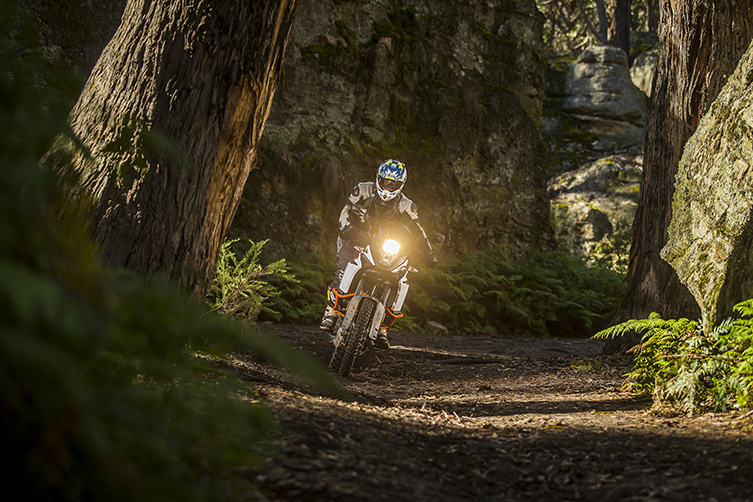
Let’s come back to the suspension upgrades, which you say represent the most significant mods to the 2017 bikes. Talk us through the component upgrades?
Well, the fork on the 2017 1090R and 1290R has adopted the hydro-stop design used in the WP 48mm Xplor fork (that was introduced to KTM’s EXC range for 2017), plus both the damping and spring rate have been beefed up (the fork springs have gone from 5.5 to 6.5N/mm). Because the hydro-stop used in the R-models’ 48mm WP fork is now longer and sealed, it offers much-improved bottoming resistance. Previously, when the spring guide entered the hydro-stop, oil could easily be pushed out the bottom or top. With the sealed system, the oil must exit back past the spring guide, which means its flow is a lot more controlled. Plus the entry to the hydro-stop is tapered to ensure a more progressive feel toward the end of the fork’s 220mm stroke.
On the bikes’ rear-ends, the no-linkage system remains for 2017, but the shock absorber is completely new. The previous shock relied on a heavy spring and single piston for damping, whereas the new PDS2 shock system – which now features two pistons – has progressive damping built into it. So, as the shock moves deeper into its travel, the second piston comes into play to assist and bolster the damping. To get the same bottoming resistance on the previous shock, you’d need to beef up the spring and damping settings so much, you’d lose that comfort in the first part of the stroke. With the PDS2, you get better bottoming resistance and still retain that compliant ride over the smaller bumps, which is an important element for bikes you tend to do longer rides aboard.
We’ve already published a piece that helps define where each of these new Adventure models ‘fit in’, but in basic terms, how do the 1290R and 1290S models differ from a componentry point of view?
They both use the same trellis frame, but the R models are easily distinguished by their added orange crash bars for protection. The 1290S runs cast 19” and 17” wheels (as opposed to the R models’ 21” and 18” spoked wheels), semi-active electronic suspension and luggage-carrying systems, plus it gets the electronic upgrades, TFT (Thin Film Transistor) LCD dash, and all the bells and whistles received by the 1290R. So, semi-active suspension aside, the S and R models are equal in terms of the technology they use, and both have the genuine ‘KTM My Ride’ accessory options available for them.
How does the 1290S’s electronic suspension work?
The 1290S’s semi-active electronic suspension uses stroke sensors and accelerometers to detect the speed and size of the compression and extension movements of the fork and shock, and the Suspension Control Unit (SCU) decides how much to slow down those movements. So a high-speed movement in the suspension will need more damping to control it, while a low-speed movement (like a G-out) requires less damping. This SCU is one of several control units on the bike, and it makes real-time adjustments to the suspension settings according to the feedback it gets from the sensors, which are found inside the WP fork and shock.
What about the “floating luggage mount” system on the 1290S?
KTM found that, at 200km/h plus on the high-speed autobahns in Europe, the buffeting created by the aluminium panniers affected the bike’s ride. So they developed a mounting system with a sliding mechanism that lets the panniers ‘float’; moving independently of the bike by only 5-10mm. At high speeds, this makes the bike’s ride much smoother.
There was a fair bit of talk at the launch about simplifying the serviceability of critical components on the 2017 bikes. What components, specifically?
The steering head bearings are a classic example. With the previous tapered roller bearings that are traditionally used for the steering head, the tension ‘test’ was how easily the wheel flopped from side to side after you’d tightened it. But some guys like a little drag; others prefer it looser. And you needed to do up two nuts – one under the triple clamp, which required a special tool, and then your conventional nut on top of the triple clamp. So when there were reports of the bikes encountering a weaving or instability problem on the really high-speed autobahns, KTM’s design team traced the issue back to incorrectly tensioned steering head bearings. Therefore, the factory introduced all-new caged ball bearings to the top and bottom of the steering stem for 2017, which have a much smaller surface area against the race. And because the race is very deep, it creates a lot more stability in every plane. In addition to it offering a very smooth movement, the design also allowed the factory to come up with one torque setting for the steering head nut, and eliminate the secondary nut under the triple clamp altogether. Now, the top triple clamp sits straight on the dust seal, and the nut is tightened from the top to a torque setting of just 18Nm, after which you re-tighten the pinch bolt. It’s a far simpler and more reliable system, and it means no one will ever be at the mercy of the ‘feel’ used by a particular mechanic.
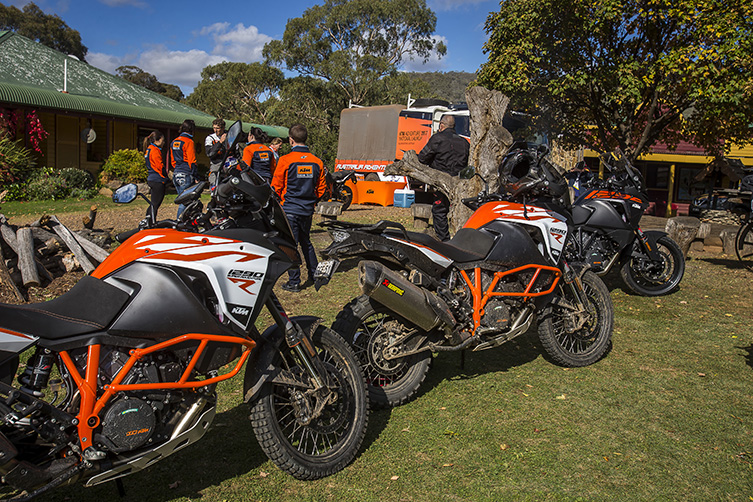
What else stands out from a serviceability point of view?
The 1190’s seat used to get very hot and uncomfortable because of the catalytic converted immediately underneath it. So for 2017, there’s a special deflector to eliminate the issue (unfortunately, you can’t retrofit this to a previous model). Speaking of heat, there’s also a deflector on the back of the radiator, so when the fan comes on, the hot air is directed out the side of the bike, and not straight into the rider’s legs. In addition to the airbox intake tract’s mesh insert that deflects water, there’s a dip and 2mm drain hole in the snorkel leading to the airbox. So if water did make it through the mesh, it can drain out before reaching the main air filter. And with the 1290R’s pre-filter, it’s now a one-bolt operation. Previously with the 1190R, you had to pull the entire side fairing off to fit or replace the Uni Filter sock. On the 2017 1290R, this factory-integrated pre-filter is an OEM part. It will be an optional PowerPart on the 1290S. In Australia, the new 1090R will be fitted with a Uni Filter pre-filter kit.
There was also a lot of talk about the subtlety of the new bikes’ “electronic intervention”. Explain that.
Okay, take the 1290’s traction control as an example. When the ECU detects that there’s excessive wheelspin, some bikes’ systems will cut the spark, fuel or cylinder to soften the power. Whereas with the KTM’s Bosch lean-angle sensor technology, working in conjunction with the Keihin engine management system, the power is softened via partially closing the inlet butterflies to reduce the RPM until everything catches up and it’s opened again. Of course, this all happens live and in milliseconds. It’s a more sophisticated TC system, which does its thing in a much more subtle way. It’s amazing how often the TC light on the dash alerts you to the fact the system is active, but you’re not physically aware of the technology at work. The 1090R also has traction control, but it’s not lean-sensitive.
More on the 2017 KTM Adventure Range
- KTM ADVENTURE RANGE: HOW EACH MODEL ‘FITS IN’
- KTM ADVENTURE RANGE: ADVENTUROUS SOUL
- KTM ADVENTURE RANGE: DESIGN INSIGHTS
- KTM ADVENTURE RANGE: THE TECHNOLOGY
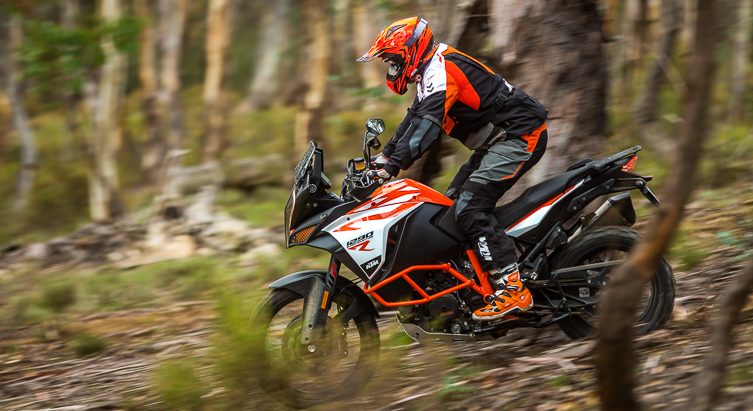
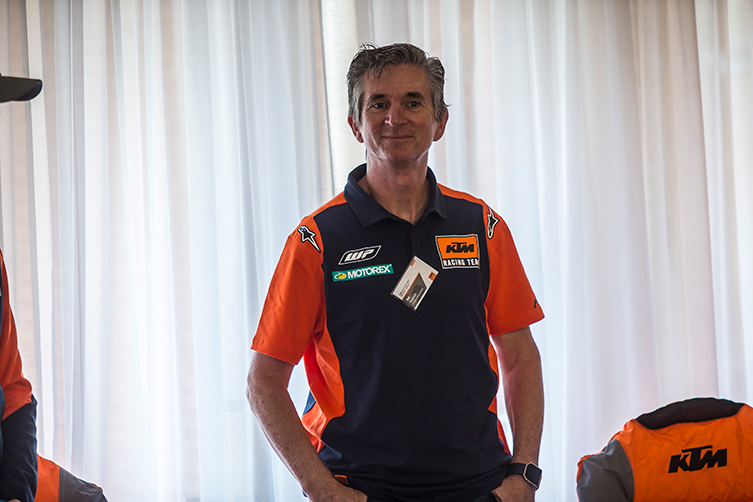
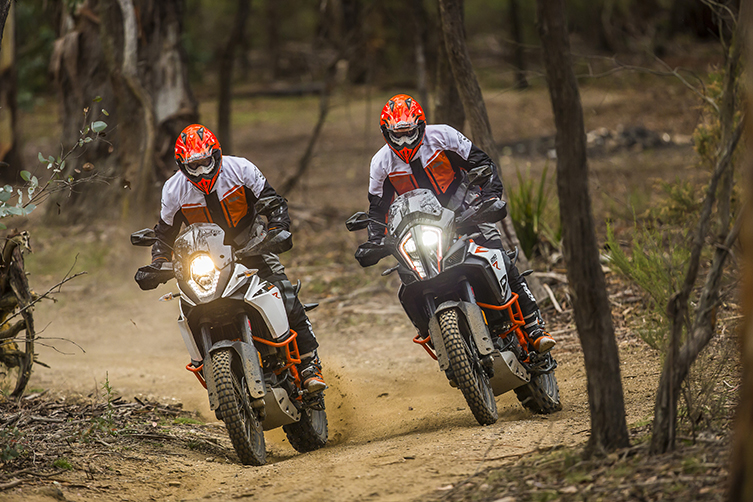
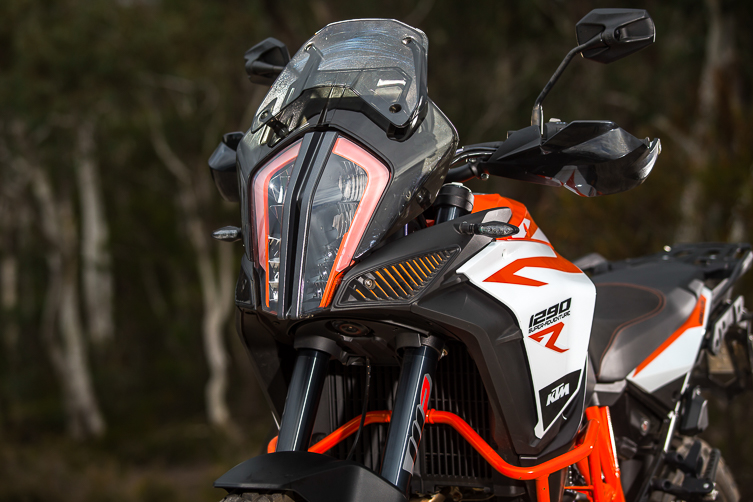
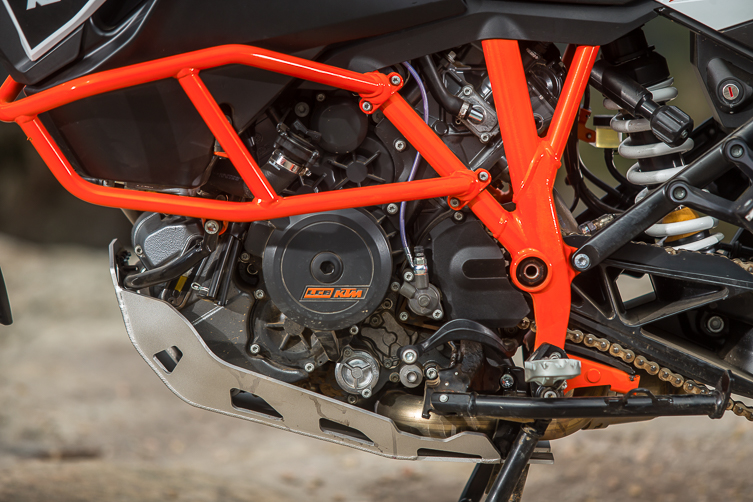
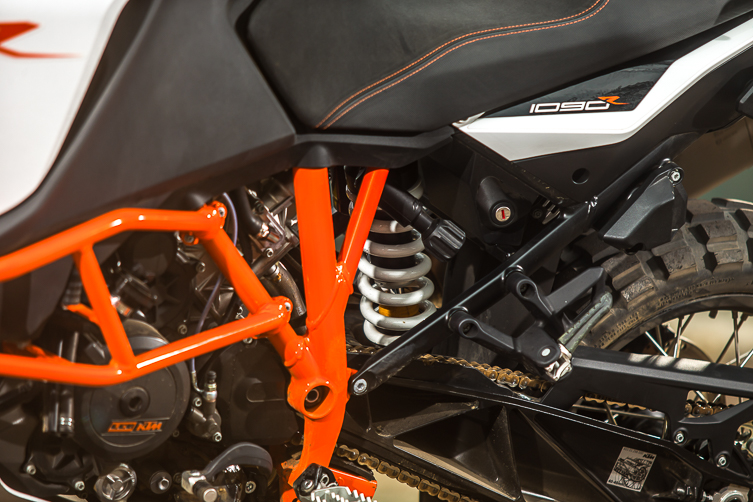
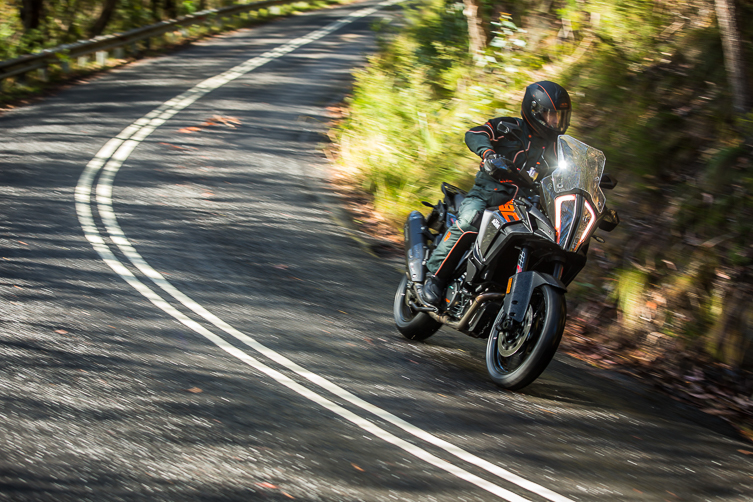
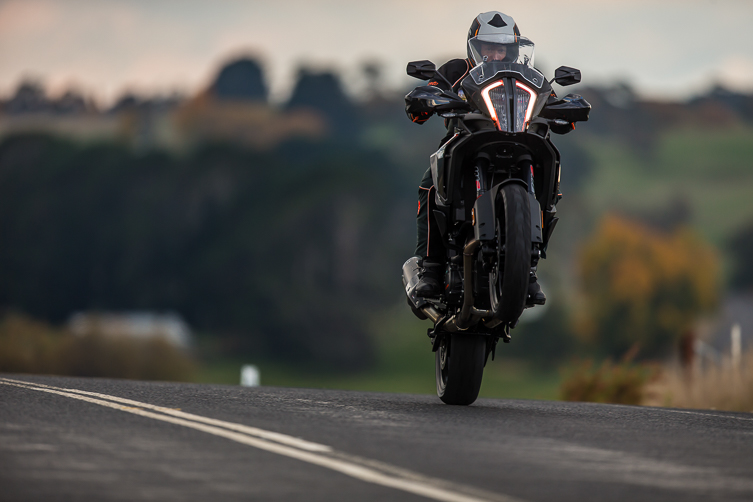
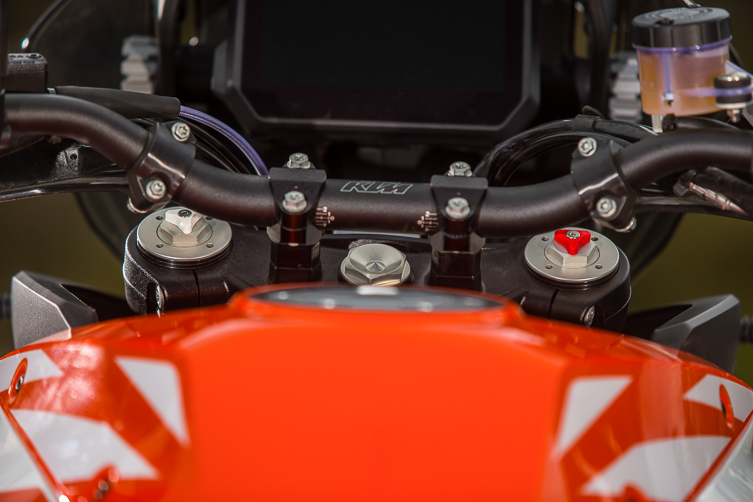
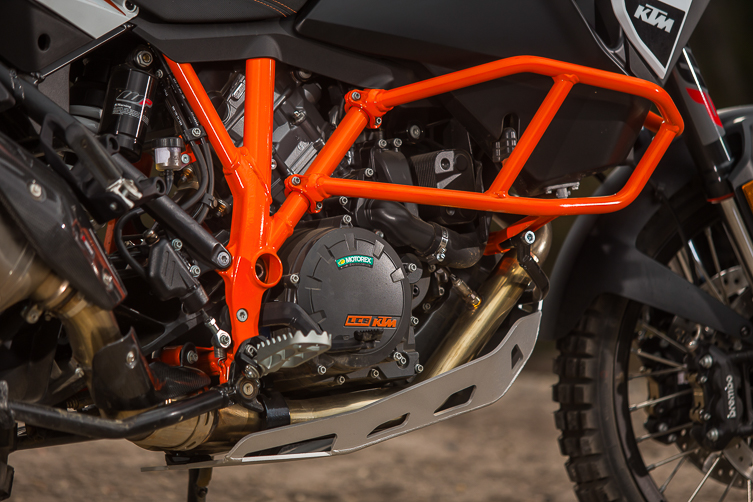







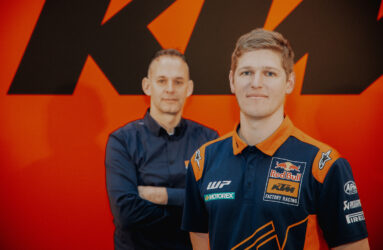
Be the first to comment...